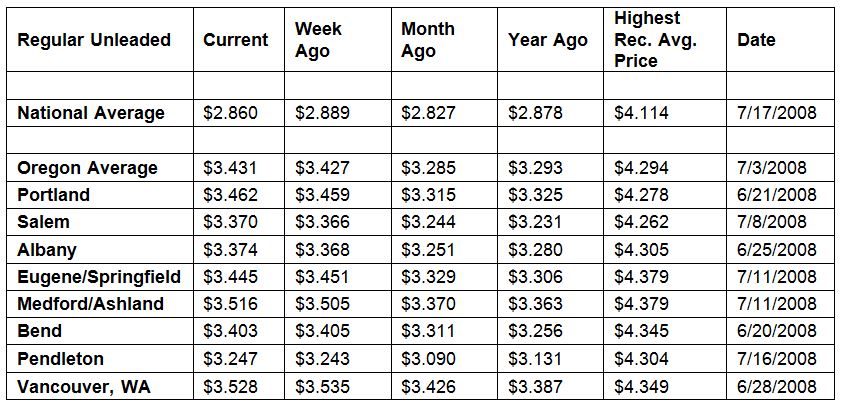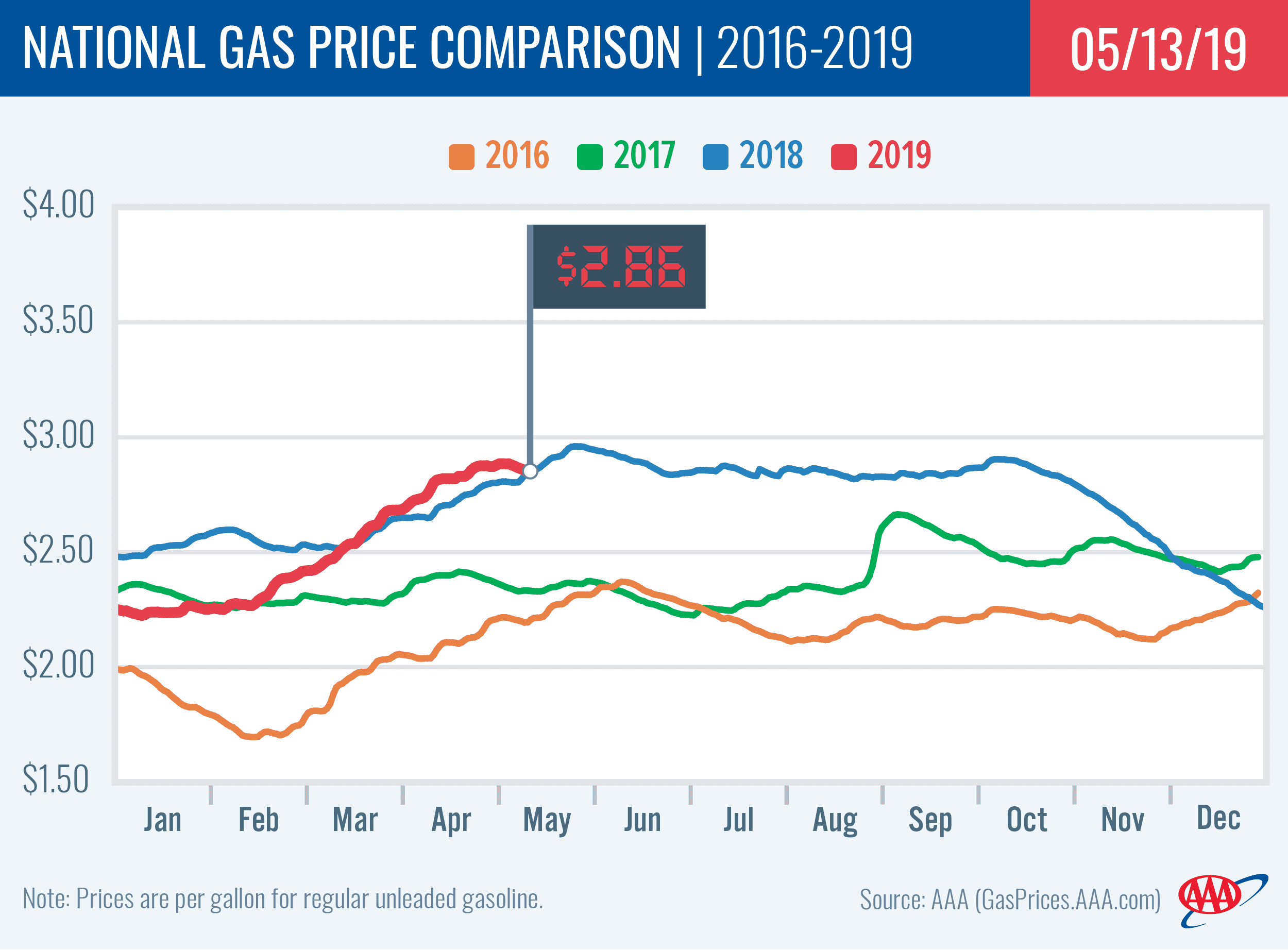Oregon average is flat while national average sees largest weekly decline in three months
PORTLAND, Ore., – Gas prices are holding steady or inching lower in most states despite an increase in demand and a decrease in gasoline stocks. For the week, the national average slips three cents to $2.86 a gallon while the Oregon average is flat at $3.43 a gallon. The Oregon average had been steadily increasing since March 1.
The latest report from the U.S. Energy Information Administration (EIA) shows that demand for gasoline is increasing to summer-like levels and that gasoline stocks are decreasing. The relatively stable pump prices may indicate that supply and demand are possibly leveling out as refinery maintenance season wraps up.
“This is the first time in about three months that gas prices have stopped climbing. However, there are numerous factors that could quickly push pump prices up again including the impact of Chinese tariffs, tensions with Iran, weather, a major draw in gasoline stock levels, a spike in demand or the volume of Memorial Day weekend travel. Pump price movements this week will indicate if drivers will continue to see cheaper gas prices or if this is just a one-week blip,” says Marie Dodds, public affairs director for AAA Oregon/Idaho.
Oregon is one of eight states where prices are flat this week, either increasing or decreasing by less than a cent. Thirty-five states and the District of Columbia have decreases of a penny or more, and seven states have increases of a penny or more. Ohio (- 9 cents) has the largest week-over-week drop while Idaho (+6 cents) has the largest weekly increase. California remains the only state with an average at or above $4 a gallon. Hawaii, Washington, Nevada, Alaska, Oregon, Idaho, Utah, Arizona, Pennsylvania and Illinois have averages at or above $3 a gallon.
Oregon is one of 33 states and the District of Columbia with higher prices now than a month ago. The national average is three cents more and the Oregon average is 15 cents more than a month ago. This is the 14th-largest monthly increase in the country. Utah (+57 cents) has the largest month-over-month jump, Idaho (+45 cents) is second and Alaska (+29 cents) is third. Florida (-9 cents) has the largest monthly decrease.
The West Coast continues to have the highest pump prices in the nation with all of the region’s states landing on the top 10 most expensive list.
California tops the list for the eighth consecutive week with Hawaii, Washington, Nevada, Alaska Oregon, and Arizona rounding out the top six.Oregon falls to sixth most expensive after a week in fifth. As mentioned above, California is the only state with an average at or above $4 a gallon. Prices in the region are showing moderate increases or decreases this week. California (-3 cents) has the biggest drop while Alaska (+3 cents) has the largest weekly increase.
The EIA’s recent weekly report for the week ending on May 3 showed that West Coast gasoline stocks fell again by approximately 400,000 bbl from the previous week and now sit at 27.1 million bbl. The West Coast may see continued price volatility and shrinking gasoline stocks this week, which will likely lead to more increases at the pump due to ongoing refinery maintenance that pushed prices in California over $4 a gallon in April.
The nation’s cheapest markets are Alabama ($2.48) and Louisiana ($2.49). For the 13th week in a row, no states have an average below $2 a gallon.
Oregon is one of 13 states where drivers are paying more than a year ago to fill up. The national average is two cents less and the Oregon average is 14 cents more than a year ago, which is the fifth-largest yearly increase in the country. California (+37 cents), Arizona (+20 cents), Nevada (+20 cents) and Washington (+15 cents) have the greatest year-over-year increases. Delaware (-18 cents) and Kentucky (-15 cents) have the largest year-over-year decreases.
Oil Market Dynamics
Crude oil prices have moved lower because of global concerns around trade negotiations between the U.S. and China. This plus reports that two Saudi oil tankers were attacked in the Strait of Hormuz are likely to keep prices volatile this week.
This week’s EIA petroleum status report revealed that crude stocks fell by 4 million bbl to 466.6 million bbl last week. While the new level is 32.8 million bbl lower than the level at this time in spring 2018, the step back is a reversal from the previous week that saw crude inventories climb by 10 million bbl. Contributing to the recent reduction in total domestic crude inventories was a slight reduction in domestic crude production to 12.2 million b/d and a drop in crude imports from 7.4 million b/d to 6.7 million b/d. The reduction in crude inventories occurred despite crude exports falling last week from 2.6 million b/d to 2.3 million b/d.
In related news, Baker Hughes, Inc. reported that the U.S. lost two oil rigs last week, bringing the country’s total to 805. When compared to this time in 2018, there are 39 fewer rigs now.
At the close of Friday’s formal trading session on the NYMEX, WTI decreased four cents to settle at $61.66. At the close of Monday’s formal trading session on the NYMEX, WTI lost 62 cents to close at $61.04. Today crude is trading around $62, compared to $61 a week ago. Crude prices are down about three percent in the last month and are about $10 per barrel less than a year ago.
Drivers can find current gas prices along their route with the free AAA Mobile app for iPhone, iPad and Android. The app can also be used to map a route, find discounts, book a hotel and access AAA roadside assistance. Learn more at AAA.com/mobile.
Diesel
For the week, the national average is flat at $3.10 a gallon. Oregon’s average holds steady at $3.30. A year ago the national average for diesel was $3.14 and the Oregon average was $3.37.
Find current fuel prices at GasPrices.AAA.com.
AAA news releases, high resolution images, broadcast-quality video, fact sheets and podcasts are available on the AAA NewsRoom at NewsRoom.AAA.com.



